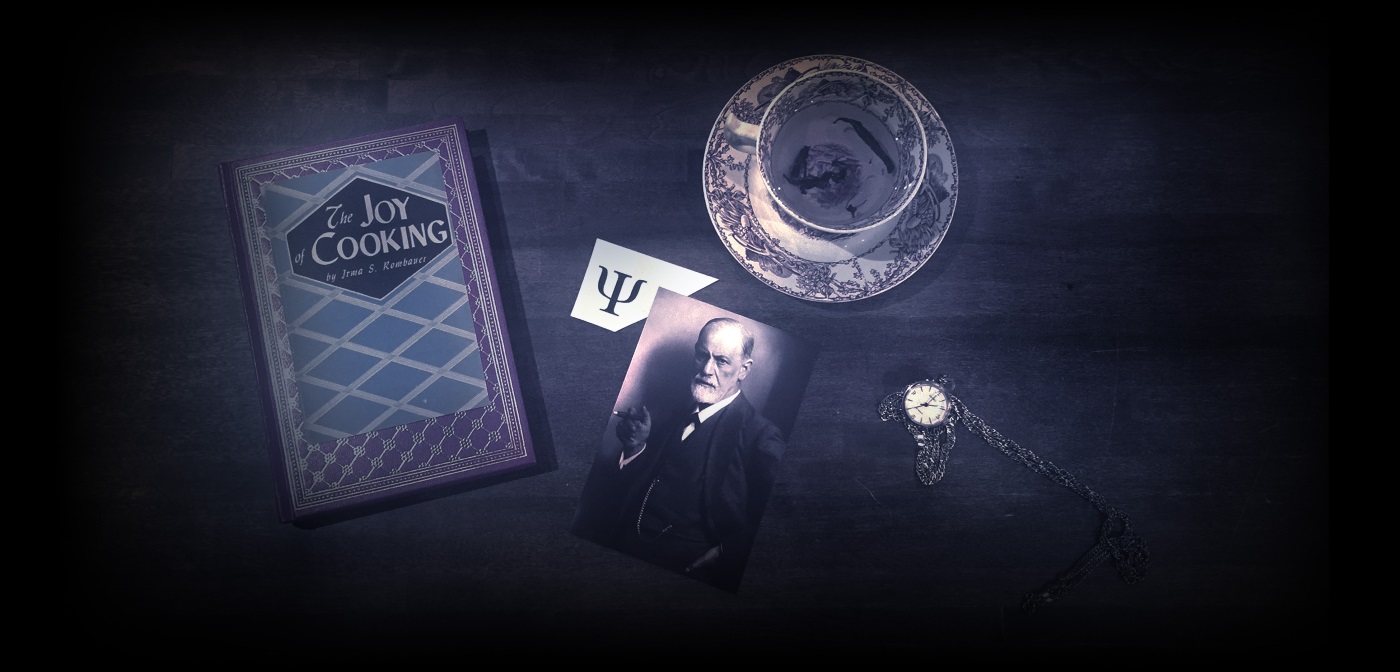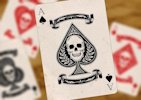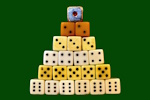Game Design Analysis - Ahnayro: The Dream World
- Game Design, Video Games

Earlier this year, I had the chance to visit Alice & Smith, a small video game studio specialized in transmedia storytelling, and most notably known for the alternate reality game (ARG) The Black Watchmen. How that visit came to be is a crazy story that I hope to share in the future. For now, what matters is that the company's Chief Storyteller, Andrea Doyon (informally known as anashel), was kind enough to offer me a copy of their games.
Today, I would like to share my analysis of one of them, Ahnayro: The Dream World which I have played on Windows. For reference, I invested about 6 hours of play time into the game. I have not completed the game, nor plan to do so, and will explain why below.
Facts
Concept
The basic idea behind Ahnayro: The Dream World is to have the player explore dream-like thoughts presented as fragments that are loosely tied together. The objective is to find the various connections between them using information from the real world, and unveil the truth behind their meaning.
Gameplay
The player must solve puzzles that are incrementally unlocked through a tree. During my playthrough, I stumbled upon two main types of puzzles: research and alternate reality. Puzzles solved are also rewarded with additional story narration.
In both cases, instead of simply entering the answer of each puzzle in a text box, the player is presented with a diagram with short strings of characters. Each diagram have around 25 character strings on them, most of them being of 2 letters, and have an indication representing the number of strings to select, usually 3, 4 or 5. Players must then enter their answer by selecting the strings in order.
Research puzzles
Most puzzles in the game are in this category. The player is presented with a few concepts in the form of riddles, images, voice recordings and pieces of information, and must find their common denominator. The answers cannot be found in the game, and external sources of information must be researched and used instead.
The answer diagram for these puzzles is presented as two embedded rings with the character strings inscribed on them.
If a player is completely stuck, the game offers up of five hints per night. Note that I have not used this feature, so I will be unable to comment on its usefulness.
Alternate reality puzzles
Puzzles in this category are presented as cards. Their front sides contains a hint, and their back sides have a riddle to solve and a grid along with the answer diagram.
The answer diagram for these puzzles is presented as a square grid. In terms of functionality, the only difference from research puzzles answer diagrams is that the same character string cannot be selected twice.
Before being presented the puzzle, the player must first open external web pages, which will appear outside of the game in the player's default web browser. These web pages are from real websites, but with fictional content. The player must then explore these websites and their related content, sometimes at hidden or protected locations, and sometimes outside the web, to solve the riddle.
As far as I'm aware, there is no built-in hint system for those types of puzzles. However, the game features a button that opens the game's official forums in the player's web browser.
Presentation
The game itself runs as a dedicated application that represents the dream world and exists to provide a hub to present clues, verify answers, and keep track of unlocked puzzles. Despite its simplicity, a lot of effort has been put in it to immerse the player, including high-quality 2D visuals, piano music, well-designed sound effects, particles effects, voiced narration, smooth transitions and even dynamic content based on the mouse position.
While attempting to solve the puzzles, the application is not in use during that time with the exception of the music. Since the primary tool the players have to solve the puzzles is their web browser, the user experience is pretty much the same as normally browsing the web for information.
As for the external fictional content, which represents the game's awake world, a good chunk of work has been invested to making everything feel real. Without spoiling anything, this is where the game feels closest to a traditional ARG, minus the disguised advertisement part.
The whole game has been designed to produce an aura of sadness and melancholy, and puzzle themes are usually centered around dark aspects of history, illnesses and death.
Technical issues
Before we go into the analysis proper, I wanted to mention a few technical issues I've encountered.
First, in the options menu, I noticed a strange option to only be able to play the game during night, which was unchecked by default. According to Andrea, the idea is that the game was designed to be played at night only for an additional immersion level. This information however is nowhere to be found in the game and confused me quite a bit.
Also, the first time I launched the game, I did so in full screen mode, but I quickly realized that it was much more convenient to play in windowed mode. I had to quit the game to fix this. It's not a big deal, but the fact that there is no in-game graphical options is a bit of an oversight.
I also found a case where the answer diagram was aligned under a menu, making the selections difficult.
Analysis
Answer diagram
The first thing that I noticed was how cumbersome it is to input an answer. Even when knowing the answer, it takes about a minute or two to do so, especially for research puzzles where characters are up-side down and hard to read due to the font. While stylish, it is an accessibility issue.
That said, despite its obtuseness, the answer diagram give a bit of extra information to the player. They can use it to determine the approximate length of the answer, the type of answer (e.g., word, sentence, acronym, number) and eliminate a few characters combinations (e.g., no letter B). A dedicated player may even be able to run an algorithm that automatically checks all combinations against a database to find potential answers, although this task is probably not practical for most players.
Research puzzles
Research puzzles pretty much ends up performing Google searches and reading Wikipedia and blog articles about general knowledge topics, while listening to the game's music in the background. This is what the player will do the most during the game. It's a very neat way to add a layer of gamification to learning. A downside is that it causes the music to become repetitive relatively quickly though.
These puzzles are also fairly unique in games though as they are primarily associative puzzles rather than logic puzzles. Because they usually require research, the puzzle part is usually about figuring out what type of information the game expects and where to find this information.
I also often ended up taking screenshots of the game, cropping a picture in it and saving it in a temporary file, in order to perform image searches. I'm fairly sure doing so is required to beat the game unless the player already knew in advance the required information, and I can't help but wonder how many players gave up because they did not know image search is a thing or how to extract images from the game to do so.
One thing that I was afraid of while playing was to stumble on walkthroughs while using a search engine. To my surprise, this happens rarely. What is common however is to see what you are about to search pop-up as an autocomplete choice because of all the other players searching for the same thing.
Another thing I did not expect was to sometimes stumble on blogs about extremely niche topics that linked clues from seemingly unrelated puzzles together based on that niche. These websites are so niche that I had to triple-check whether they were created by the game developers as hints or not. I believe their content was actually used as inspiration for the puzzles rather than the other way around, but finding them is quite revealing.
Alternate reality puzzles
The fictional content provides a lot of information about the game's universe and story, and its transmedia presentation is uncommon in games nowadays. It also provides an opportunity to present more traditional puzzles that must be solved to progress in the game, but don't fit in the normal structure of the dream world.
An attentive person should notice where the fiction starts and ends, either due to missing stuff, a nonsensical design, false claims or obvious hints. This clashes with my previous niche blogs observation.
At first, I didn't realize the alternate reality puzzles existed though. The reason is because the user interface does not indicate that the puzzle cards can be flipped, which is performed by clicking on them. I was instinctively clicking next to it instead, and happened to click on one once by coincidence. This design probably works for touch screens on mobile devices, but for a classic desktop computer it doesn't work.
My biggest concern however is that there is a high risk the game will become unplayable in the future, as the external content requires upkeep from the developers.
Multiplayer dynamics
While the game is primarily a single-player experience, I find it interesting that the game encourages cooperation by linking to its forums directly from the game. However, because players may be at different points of progression, I believe that kind of cooperation would be more about players having solved the puzzle already giving hints to other players instead of mutual cooperation.
I can definitely see however a group trying to tackle the puzzles and secrets of the game from start to finish together as investigators, but the game does not encourage this kind of behavior. I'm not sure if it's an oversight or if it's by design, but I think there's a missed opportunity there.
Fun factor
This is where the game falls apart in my opinion. You can have an incredibly well-designed game, but if it isn't fun, there's not much point to it.
My biggest pet peeve is the research part, which is the most mundane thing someone can do on the Internet and also what the player will do the most. I'm sure some people like to do this for the sake of learning, but personally I feel that the researched subject matter itself must be interesting to be fun. However, in this game, the topics to be researched are depressing by design, which is an issue.
The reflection process behind solving research puzzles does not feel very fun either. It is mostly done passively through intuition, and normally the epiphany would be the fun moment of this reflection. However, in this case, the epiphany is often not strong because it is limited to noticing a repeated piece of information between different sources, or the solution is written directly in a source.
The alternate reality content is a breath of fresh air compared to research puzzles and non-ARGs, but because it doesn't feel natural due to the reasons I mentioned earlier, it breaks the immersion. It's also not clear if you already have all the elements required to solve real world puzzles stumbled upon or if you need to unlock more content in the dream world first, which is a bit frustrating and also encourages giving up on solving puzzles in the game in general.
In the end, the only hook the game has beyond learning for learning's sake is to unravel the mystery of the narrator inhabiting the dream world. Unfortunately, the game doesn't give the player much reason to be emotionally invested in this mystery. Talking about nightmares and feelings don't build much empathy as they are meaningless without context, and the nature of the story progression, which is a mix of abstract dreams and detached reports, doesn't help. I can't comment on how satisfying everything connects together in the end, but what I can say is that the journey to reach that end has issues.
Final thoughts
Ahnayro: The Dream World proves it's possible to create a fun experience with non-logical puzzles. It also proves to be a foundation for a good teaching tool. On these aspects, I'm glad the game exists and that I had the chance to play it. However, in the end its game design leaves a bit to be desired despite a decent amount of polish in its execution as it feels too much like homework.
Here are a few ideas I can think of to improve the game's design for my tastes. Note that some of them may be mutually exclusive:
- A more diverse set of research topics.
- Happier and livelier themes.
- Faster story progression.
- More interactivity between the dream world and the real world. (To clarify, in the game, players are probing from both extremes towards the mystery in the middle instead of a more interconnected approach.)
- Not having to rely on external knowledge to solve puzzles.
- A more traditional "whodunit" approach to solve the mystery.
That said, if you like poetry, solving abstract puzzles and researching general knowledge topics, I suggest you give this game a try.
I will conclude this post with what I believe is the most memorable quote of the game: "Brains. Yum."
Post image: © 2016 Alice & Smith
Related content I wrote

How to Play Liar's Deck (From Liar's Bar) - Full Rules and Variants
- Video Games, Game Design
The following are the rules of the Liar's Deck bluffing card game and its official variants, first introduced in the Liar's Bar video game. These rules are based on its in-game tutorials, observations I made from gameplay sessions, and comments from the game's developers. While there may be a few…

The New Open Source Video Game Randomizer List Is Now Live
- Video Games, Programming
Time to update your bookmarks! After a few months of work behind the scenes, the new open source version of The BIG List of Video Game Randomizer is now live for your enjoyment, with dark mode support and a brand new UI for better readability! The new URL is: https://randomizers.debigare.com/ (The…

The Future of the Video Game Randomizer List
- Video Games, Programming, Anecdotes
It's hard to believe that it's been almost 8 years since I first posted on the ROMhacking.net forums a list of video game randomizers that I found online, and that it would evolve into the massive project it has become today, with almost 900 entries currently being listed. It's always a strange…

My Personal Video Game Completion List
- Anecdotes, Video Games
I thought it would be fun to track the long list of video game that I have beaten and/or completed for reference, so I've done just that! There may be a few mistakes here and there due to secret features unknown to me, or due to misremembering details of my past gaming experiences, but I believe the…

I Designed the Perfect Gambling Game, But...
- Mathematics, Business, Game Design
Back in 2006-07-08, during the 13th Canadian Undergraduate Mathematics Conference at McGill University, I presented a gambling game I designed with the novel property of being both advantageous to players and the house, and that despite this proprety, that pretty much nobody in their right mind…